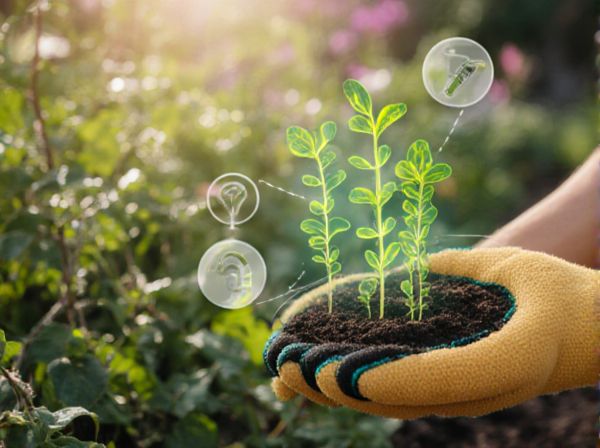
Photosynthesis rates vs photoinhibition Illustration
Photosynthesis rates increase with sunlight intensity up to an optimal point, where the chloroplasts efficiently convert light energy into chemical energy. Beyond this threshold, excessive sunlight leads to photoinhibition, damaging the photosynthetic apparatus and reducing overall productivity. Managing light exposure is crucial to balance maximizing photosynthesis while preventing photoinhibition in plants.
Table of Comparison
| Parameter | Photosynthesis Rate | Photoinhibition |
|---|---|---|
| Definition | Process converting light energy into chemical energy | Reduction in photosynthetic efficiency due to excess light |
| Optimal Sunlight Intensity | Moderate to high sunlight (100-1,000 mmol photons m-2 s-1) | Excessive sunlight (>1,500 mmol photons m-2 s-1) causes damage |
| Effect on Plant | Increases growth and biomass accumulation | Damages photosynthetic apparatus, reducing growth |
| Duration Impact | Sustained efficient energy conversion under balanced light | Long exposure leads to chronic inhibition and stress |
| Recovery | Continuous under optimal light; supports plant vitality | Slow; requires reduced light conditions for repair |
| Key Metrics | CO2 assimilation rate, chlorophyll fluorescence | Decrease in PSII efficiency (Fv/Fm ratio), reactive oxygen species |
Understanding Photosynthesis Rates in Garden Plants
Photosynthesis rates in garden plants peak under optimal sunlight intensity but decline when light intensity exceeds a threshold, causing photoinhibition and damage to the photosynthetic apparatus. Chlorophyll absorption efficiency and stomatal conductance regulate carbon fixation and water loss, directly influencing photosynthetic capacity. Monitoring light intensity and adjusting plant positioning can maximize photosynthetic efficiency and minimize photoinhibition risks in diverse garden environments.
What is Photoinhibition? Causes and Effects
Photoinhibition is the light-induced reduction in the photosynthetic capacity of plants, occurring when excess sunlight damages the photosystem II (PSII) reaction centers. This process is primarily caused by high light intensity, UV radiation, and environmental stresses such as drought or temperature extremes that impair the repair mechanisms of PSII. The effects of photoinhibition include decreased photosynthesis rates, reduced plant growth, and lower crop yields due to impaired energy conversion efficiency.
Sunlight Intensity: Optimizing Photosynthesis
Sunlight intensity directly impacts photosynthesis rates, with moderate levels enhancing chlorophyll activity and carbon fixation efficiency. Excessive sunlight leads to photoinhibition, where damage to photosystem II reduces photosynthetic capacity and plant growth. Optimizing sunlight exposure balances maximizing photosynthetic output while minimizing photodamage, critical for sustained plant productivity and energy capture.
Photoinhibition: When Sunlight Becomes Too Much
Photoinhibition occurs when excess sunlight damages the photosynthetic apparatus, reducing photosynthesis rates despite abundant light. Excessive light energy leads to the overexcitation of chlorophyll molecules, causing the formation of reactive oxygen species that impair photosystem II efficiency. This protective mechanism limits photodamage by downregulating photosynthetic activity, balancing energy capture with cellular repair processes.
Balancing Shade and Sun for Healthy Growth
Photosynthesis rates peak under optimal sunlight exposure but decline when excessive light causes photoinhibition, damaging chlorophyll and reducing energy conversion efficiency. Plants balance shade and sun by adapting leaf orientation and pigment composition to maximize light absorption while minimizing oxidative stress. Properly managed light conditions promote healthy growth by sustaining photosynthetic activity without triggering photoinhibitory damage.
Key Factors Affecting Photosynthesis Efficiency
Photosynthesis efficiency is primarily influenced by light intensity, wavelength, and duration, with optimal sunlight promoting maximum carbon fixation rates. Excessive light leads to photoinhibition, where chlorophyll molecules become damaged and the photosynthetic apparatus slows down, reducing overall productivity. Temperature, CO2 concentration, and nutrient availability also interact with light conditions to modulate photosynthetic rates and minimize photoinhibition effects.
Signs of Photoinhibition in Your Garden
Signs of photoinhibition in your garden include wilted leaves, reduced leaf size, and chlorosis, which indicate damage to the photosynthetic apparatus caused by excessive sunlight. Photosynthesis rates decline as photoinhibition disrupts the function of photosystem II, impairing the plant's ability to convert light energy into chemical energy. Monitoring these symptoms helps optimize sunlight exposure and maintain healthy photosynthesis rates for robust plant growth.
Strategies to Prevent Photoinhibition
Plants utilize protective mechanisms such as non-photochemical quenching (NPQ) to dissipate excess light energy as heat, preventing photodamage during high sunlight exposure. The xanthophyll cycle plays a critical role in modulating light harvesting, adjusting the photosynthetic apparatus to balance energy capture and photoprotection. Chloroplast movement and the synthesis of antioxidant enzymes like superoxide dismutase further reduce reactive oxygen species, enhancing tolerance to photoinhibition and maintaining optimal photosynthesis rates.
Plant Adaptations for Managing Sunlight Stress
Plants optimize photosynthesis rates by developing protective pigments and dynamic leaf orientations that minimize photoinhibition under intense sunlight. Specialized mechanisms like non-photochemical quenching safely dissipate excess light energy, preventing damage to the photosynthetic apparatus. Adaptive traits such as thicker leaf cuticles and increased antioxidant production enhance resilience to sunlight stress and maintain efficient energy conversion.
Maximizing Garden Productivity Through Light Management
Optimizing photosynthesis rates while minimizing photoinhibition is crucial for maximizing garden productivity under sunlight exposure. Proper light management techniques, such as using shade cloths or strategic plant placement, help maintain ideal light intensity that enhances chlorophyll absorption and energy conversion. Monitoring light levels prevents excessive radiation that causes photoinhibition, ensuring sustained photosynthetic efficiency and healthier plant growth.
Photosynthesis rates vs photoinhibition Infographic

 gardendif.com
gardendif.com